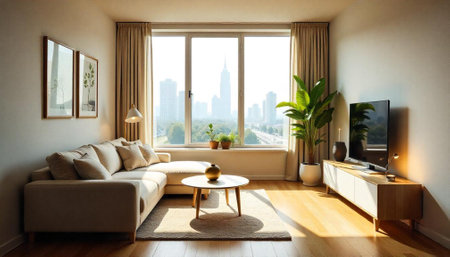Introduction to Modern British Interiors
The story of British interiors is a rich tapestry woven from centuries of heritage, craftsmanship, and an ever-evolving design sensibility. From the grandeur of stately homes and the elegant restraint of Georgian townhouses to the bold statements of mid-century modern flats, interior design in the UK has always reflected the nation’s diverse cultural influences and social shifts. In recent years, this evolution has accelerated, as contemporary British interiors embrace a harmonious blend of tradition and innovation. Today’s spaces effortlessly combine the raw textures of industrial chic with an unwavering commitment to sustainability and urban practicality. This new wave of design not only honours Britain’s storied architectural past but also reimagines it for the demands—and dreams—of modern living.
2. Industrial Chic: Embracing Urban Character
Industrial chic has emerged as a defining aesthetic in modern British interiors, seamlessly blending the grit of urban landscapes with an unmistakable sense of sophistication. At its core, this design movement captures the spirit of Britains post-industrial cities—think London’s converted warehouses or Manchester’s reimagined mills—where history and contemporary living intertwine.
A key feature of British industrial chic is the celebration of repurposed materials. Homeowners and designers alike are drawn to salvaged timber, reclaimed metals, and vintage fixtures sourced from local markets or architectural salvage yards. These materials not only add authenticity but also reflect a conscious approach to sustainability—a value at the heart of today’s British design ethos.
The raw beauty of exposed brickwork has become a signature statement within these spaces. Whether it’s an original Victorian wall or newly laid brick that mimics heritage construction, this element provides texture and warmth while evoking the industrial past. Paired with steel beams, visible ductwork, and polished concrete floors, the look is both honest and inviting.
Utilitarian forms further define the industrial chic style. Furniture and lighting often borrow from factory origins: sturdy metal-framed tables, Tolix chairs, and pendant lights with enamel shades are common choices. The palette tends towards neutral tones—greys, blacks, earthy browns—which allow natural textures to take centre stage.
Common Elements in British Industrial Chic Interiors
| Element | Description | Cultural Relevance |
|---|---|---|
| Repurposed Materials | Salvaged wood, recycled metal, vintage fixtures | Emphasises sustainability and historical narrative |
| Exposed Brickwork | Original or imitation brick walls left unfinished | Pays homage to Britain’s industrial architecture |
| Utilitarian Forms | Factory-inspired furniture and lighting | References Britain’s manufacturing heritage |
| Neutral Palette | Shades of grey, black, brown, muted colours | Reflects understated British sensibility |
| Open Plan Layouts | Minimal partitions, flexible space usage | Mimics converted warehouse living in urban centres |
This approach to interior design is more than just an aesthetic choice; it represents a broader cultural shift towards urban regeneration across the UK. By embracing the legacy of industrial spaces and infusing them with new life, British homes are celebrating their unique character while paving the way for sustainable and meaningful living environments.
![]()
3. Sustainable Design: Green Living in the City
In the heart of Britain’s bustling cities, sustainable design is no longer a fringe movement but a defining feature of modern interiors. The eco-conscious urban dweller seeks not just style, but responsibility—a harmony between contemporary aesthetics and the wellbeing of our planet. This shift is evident in the materials, practices, and philosophies shaping today’s British homes.
Eco-Friendly Materials: A Return to Roots
The new wave of interior design favours organic textures and natural finishes. Reclaimed timber flooring, recycled glass tiles, and responsibly-sourced woollen textiles bring warmth and authenticity into urban flats. These choices echo a distinctly British appreciation for craftsmanship and heritage, while ensuring every element contributes to a lighter environmental footprint.
Upcycling: Creative Reimagination
Upcycling has become an art form in British interiors, transforming vintage finds and industrial remnants into statement pieces. An old Chesterfield sofa reupholstered with remnant fabrics or a salvaged factory light suspended above a dining table tells stories of both past lives and present creativity. This approach celebrates sustainability without compromising on character or charm.
Energy-Conscious Practices for Everyday Living
The push for sustainability extends beyond aesthetics into the daily rhythms of urban living. LED lighting, smart thermostats, and efficient insulation are now essentials rather than afterthoughts. Floor-to-ceiling windows maximise natural daylight, reducing reliance on artificial light while connecting city dwellers with the ever-changing British skies. This mindful integration of technology supports comfort and energy savings in equal measure.
As more Londoners and Mancunians embrace green living, sustainable design is redefining what it means to live well in the city—proving that beauty and ethics can flourish side by side within the walls of every modern British home.
4. Maximising Small Spaces: Solutions for Urban Living
In the heart of British cities such as London, Manchester, and Bristol, compact living is not just a necessity—it’s become an art form. The rise of modern British interiors celebrates smart space planning, multipurpose furnishings, and ingenious storage solutions that reflect both the limitations and creative spirit of urban homes. Driven by the growing demand for city centre accommodation and the architectural legacy of Victorian terraces and Edwardian maisonettes, maximising small spaces has inspired a new wave of design ingenuity.
Smart Space Planning
Urban dwellers are reimagining traditional layouts to create open-plan living areas that flow seamlessly from one function to another. Strategic use of zoning—through rugs, lighting, or subtle changes in floor level—defines distinct areas for relaxing, dining, and working without adding walls or clutter. This approach not only enhances visual spaciousness but also encourages a flexible lifestyle suited to the fast pace of city life.
Multipurpose Furnishings
Furniture choices are increasingly clever and adaptable. Think extendable dining tables that double as workstations, sofas with hidden storage compartments, and wall-mounted desks that fold away when not in use. These pieces are not only practical but also embody the minimalist aesthetic so popular in contemporary British interiors.
Popular Multipurpose Furniture in British Homes
| Furniture Type | Main Use | Secondary Function |
|---|---|---|
| Sofa Bed | Seating | Guest Bed |
| Ottoman Storage Bench | Seating/Footrest | Concealed Storage |
| Drop-leaf Table | Dining/Workspace | Saves Space When Folded |
| Wall-mounted Desk | Workstation | Folds Away Neatly |
| Ladder Shelf Unit | Display/Storage | Takes Up Minimal Floor Space |
Clever Storage Solutions Inspired by British Ingenuity
The British knack for finding hidden nooks and crannies is evident in innovative storage concepts. Under-stair cupboards are transformed into pantries or bike stores; alcoves become built-in bookshelves; and even awkward eaves are fitted with custom drawers or wardrobes. Vertical space is fully exploited with floor-to-ceiling shelving and hanging organisers—ideal for making every inch count in tight quarters.
The Urban Living Mindset: Function Meets Flair
This resourceful approach to interiors is more than just practical—it’s part of a broader cultural shift towards sustainability and conscious consumption. By investing in quality pieces that serve multiple purposes and designing homes around real-life needs rather than fleeting trends, modern Britons are crafting spaces that are both beautiful and brilliantly functional—a true reflection of urban living at its best.
5. Celebrating Local Craftsmanship and Authenticity
Modern British interiors have increasingly embraced the unique character of local craftsmanship, placing a premium on authenticity and heritage. This resurgence is not merely nostalgic; it is a conscious movement towards celebrating the artistry that has long defined British design. From hand-thrown ceramics crafted in Cornwall to bespoke joinery from Yorkshire workshops, every detail adds a sense of place and story to contemporary homes.
Highlighting Homegrown Artisans
The renewed appreciation for British artisans is evident in the way designers and homeowners source one-of-a-kind pieces. Makers such as potters, metalworkers, and textile weavers infuse spaces with textures, forms, and finishes that cannot be replicated by mass production. Their work lends an intimate human touch—each imperfection a mark of genuine skill. This artisanal approach sits at the heart of modern British interiors, blending seamlessly with industrial chic’s raw materials or sustainable innovations.
The Enduring Allure of Heritage Brands
Heritage brands like Ercol, Anglepoise, and Farrow & Ball continue to inspire with their commitment to quality and timeless design. These stalwarts marry traditional techniques with contemporary aesthetics, ensuring their products feel both rooted and relevant. Whether it’s a reissued mid-century armchair or a paint shade inspired by the British landscape, these brands connect today’s interiors with generations past—infusing rooms with stories only time can tell.
Bespoke Details: A Sense of Place
No detail is too small when crafting an interior that feels distinctly British. Bespoke design elements—such as custom cabinetry, handcrafted ironmongery, or locally sourced stone—anchor homes in their surroundings. These choices reflect not only personal taste but also a respect for regional identity and sustainability. In urban apartments or countryside retreats alike, this focus on craftsmanship elevates everyday living into something enduringly meaningful.
6. The Influence of British Lifestyle on Interior Choices
British interiors have long been shaped by the rhythms of daily life and cherished social rituals, weaving a tapestry that is as much about comfort as it is about style. Modern British design, while forward-thinking, remains intimately connected to these lifestyle traditions—afternoon tea, the conviviality of pub culture, and the vibrant bustle of weekend markets—all subtly informing how spaces look and feel.
Afternoon Tea: Embracing Comfort and Elegance
The ritual of afternoon tea, with its sense of occasion and quiet refinement, inspires interiors that favour inviting palettes—soft greys, muted blues, and gentle pastels. Living rooms and dining areas are often designed as multifunctional spaces for gathering, featuring plush armchairs, subtle floral motifs, and carefully curated tableware. The layout encourages lingering conversation, echoing the leisurely pace of this beloved custom.
Pub Culture: Sociability in Spatial Design
Britain’s storied pub culture brings an unmistakable warmth into modern homes. Open-plan kitchens flow seamlessly into living areas, creating communal zones reminiscent of a welcoming public house. Dark wood accents, exposed brickwork, and industrial lighting nod to urban chic while fostering sociability. These interiors invite relaxation—a place where friends can gather for a pint or a casual meal, blurring the boundaries between private retreat and public conviviality.
Weekend Markets: Eclecticism Meets Sustainability
The energy of British weekend markets infuses interiors with eclectic charm and sustainability-driven choices. Vintage finds mingle with contemporary pieces; reclaimed timber tables sit alongside locally crafted ceramics. This blend creates layered environments that celebrate individuality and provenance. Layouts remain flexible and unpretentious—spaces adapt to the needs of the moment, whether it’s hosting a brunch or showcasing new market treasures.
A Palette Inspired by Everyday Life
Ultimately, the influence of British lifestyle manifests in comforting colour palettes—think earthy greens from Hampstead Heath, ochres inspired by Cotswolds stone, or the moody blues of a rainy London afternoon. Relaxed layouts prioritise ease and adaptability, reflecting a way of living that values both tradition and innovation. In this way, modern British interiors become not only beautiful but deeply personal sanctuaries grounded in everyday joy.
7. Looking Ahead: The Future of British Interiors
The evolution of British interiors is an ongoing narrative, intricately woven with threads of tradition, innovation, and cultural nuance. As we look ahead, emerging trends promise to redefine the spaces we call home, balancing the legacy of industrial chic with a conscious embrace of sustainability and urban sophistication. British design continues to stand at the crossroads of global inspiration and local identity, crafting interiors that speak both to contemporary sensibilities and enduring heritage.
Emerging Trends Shaping Tomorrow’s Spaces
One of the most prominent directions is the resurgence of biophilic design, bringing nature indoors through living walls, tactile materials, and organic forms. This not only enhances aesthetic appeal but also fosters wellbeing—an essential consideration in fast-paced urban environments like London or Manchester. Meanwhile, colour palettes are becoming more experimental, as designers move beyond classic neutrals to incorporate rich ochres, deep greens, and bold blues, all echoing the vibrant British landscape.
Technological Integration: Smart Living Redefined
Technology is seamlessly blending into the very fabric of modern British homes. From energy-efficient lighting systems to intelligent climate control and voice-activated assistants, smart technology is elevating daily living while remaining unobtrusive. The integration of such innovations allows residents to enjoy greater comfort and convenience without compromising on style—an ethos that sits at the heart of British design thinking.
Global Influence Meets Local Craftsmanship
The future of British interiors will undoubtedly be shaped by a dialogue between international trends and local craftsmanship. There’s a growing appreciation for artisanal techniques—from hand-thrown ceramics in Stoke-on-Trent to bespoke joinery in Cornwall—paired with global influences like Scandinavian minimalism or Japanese wabi-sabi aesthetics. This fusion creates truly unique spaces that celebrate both global connectivity and regional authenticity.
As British interiors continue to evolve, they will reflect not just changing tastes but also shifting values. Sustainability remains a guiding principle, with upcycled furnishings, eco-friendly paints, and reclaimed materials taking centre stage. At the same time, urban living encourages flexible layouts and multi-purpose furniture that adapt effortlessly to compact city flats or sprawling suburban homes. In this ever-changing landscape, one thing remains certain: British interiors will keep redefining what it means to live beautifully and responsibly in a modern world.


